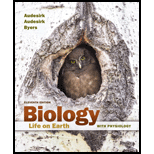
Biology: Life on Earth with Physiology Plus Mastering Biology with Pearson eText -- Access Card Package (11th Edition)
11th Edition
ISBN: 9780133910605
Author: Gerald Audesirk, Teresa Audesirk, Bruce E. Byers
Publisher: PEARSON
expand_more
expand_more
format_list_bulleted
Concept explainers
Question
Chapter 25, Problem 7RQ
Summary Introduction
To describe:
The differences between mammals and birds and what adaptations are common between mammals and birds.
Introduction:
Birds and mammals both have been evolved from reptiles. They carried many useful characters of reptiles and developed more suitable characters other than reptiles. Many adaptations are common between mammals and birds, while many adaptations make them different from each other.
Expert Solution & Answer
Want to see the full answer?
Check out a sample textbook solution
Students have asked these similar questions
What are the physical differences between Primates and Homo Sapiens?
What characteristics do primates and rodents have in common?
Which group of animals are birds more closely related to? Reptiles or Rodents?
What do amphibians,reptiles,birds,rodents and primates have in common?
What characteristics is unique only to birds and reptiles?
Fish and primates have a common ancestor. What characteristics does this ancestor have?
How are humans related to primates? What characteristics do you see in humans, either anatomically or behaviorally, that are still shared with other primates?
Chapter 25 Solutions
Biology: Life on Earth with Physiology Plus Mastering Biology with Pearson eText -- Access Card Package (11th Edition)
Ch. 25.1 - describe the features that distinguish chordates...Ch. 25.2 - name and describe the chordates that are not...Ch. 25.2 - name and describe the craniates that are not...Ch. 25.2 - describe the key adaptations of vertebrates?Ch. 25.2 - Prob. 1CSCCh. 25.3 - Most sharks avoid humans, but large sharks of some...Ch. 25.3 - With regard to water regulation (maintaining the...Ch. 25.3 - Prob. 2TCCh. 25.3 - Consider the graph shown in Figure E25-2. Imagine...Ch. 25.3 - Prob. 4TC
Ch. 25.3 - describe the key features of lampreys,...Ch. 25.3 - name and describe the main subgroups included...Ch. 25.3 - Prob. 1CSRCh. 25 - The two groups of mammals with the largest number...Ch. 25 - Prob. 2MCCh. 25 - Prob. 3MCCh. 25 - Prob. 4MCCh. 25 - Prob. 5MCCh. 25 - Prob. 1FIBCh. 25 - Prob. 2FIBCh. 25 - Prob. 3FIBCh. 25 - Prob. 4FIBCh. 25 - Prob. 5FIBCh. 25 - Briefly describe each of the following...Ch. 25 - Prob. 2RQCh. 25 - List four distinguishing features of chordates.Ch. 25 - Prob. 4RQCh. 25 - List the adaptations that distinguish reptiles...Ch. 25 - Prob. 6RQCh. 25 - Prob. 7RQCh. 25 - Prob. 1ACCh. 25 - Prob. 2AC
Knowledge Booster
Learn more about
Need a deep-dive on the concept behind this application? Look no further. Learn more about this topic, biology and related others by exploring similar questions and additional content below.Similar questions
- What are the key evolutionary adaptations that diving mammals use to survive at significant ocean depths?arrow_forwardWhat are the five classes of vertebrates? To which of these do human beings belong?arrow_forwardWhat is a primate and why do anthropologists consider it important to study them? What features do primatologists look for to distinguish between prosimians, new world monkeys, old world monkeys and apes?arrow_forward
- How are tarsiers different from all other primates? How are African-Eurasian monkeys different from apes?arrow_forwardWhy do you think baleen whales are generally larger than toothed whales? Why are they capable of growing larger than even the largest dinosaurs?arrow_forwardWhat similarities are present in birds and reptiles in terms of their external features?arrow_forward
- How does the need for dietary vitamin C show that humans are more closely related to other primates than to other mammals?arrow_forwardHow do the non-human primates interact in general? How is their speciality similar to humans?arrow_forwardWhat are the largest animals ever to have lived on Earth? From what animals are they thought to have evolved?arrow_forward
arrow_back_ios
SEE MORE QUESTIONS
arrow_forward_ios
Recommended textbooks for you
 Biology: The Dynamic Science (MindTap Course List)BiologyISBN:9781305389892Author:Peter J. Russell, Paul E. Hertz, Beverly McMillanPublisher:Cengage Learning
Biology: The Dynamic Science (MindTap Course List)BiologyISBN:9781305389892Author:Peter J. Russell, Paul E. Hertz, Beverly McMillanPublisher:Cengage Learning

Biology: The Dynamic Science (MindTap Course List)
Biology
ISBN:9781305389892
Author:Peter J. Russell, Paul E. Hertz, Beverly McMillan
Publisher:Cengage Learning
From Sea to Changing Sea | Early Life in the Oceans || Radcliffe Institute; Author: Harvard University;https://www.youtube.com/watch?v=Ac0TmDf5Feo;License: Standard youtube license